A Complete Guide to Using Your TENS Machine and Getting Results Fast Manage and relieve your pain without drugs or invasive treatments, and take back control with your TENS machine. It provides safe nerve stimulation therapy to help treat many different types of acute and chronic pain, to get real results.
The following is an easy, comprehensive guide to using your TENS machine to treat a range of the most common types of pain. The settings may vary slightly according to the model of your TENS machine, so make sure you check the manual included with your unit for more specific information. Most models of TENS machines come with several pre-set programs, including:
High frequency: Frequency of 50-100 per second, pulse width of 100
Low frequency: Frequency of 2-4 per second, pulse width of 150-250
Burst: Low frequency bursts of pulses
Modulated: Ongoing variations in pulse width, frequency and intensity
All the therapy programs are based on a ¾ setting, with an output of the most comfortable intensity level for you.
Upper Body
Upper body muscles are prone to pain and aches caused by a number of things such as stress and anxiety, overexertion, blunt-force trauma, poor sleeping positions, muscle strains, contusions or bruises, dysfunctional breathing and cramps. Most upper body pains respond well to conservative care methods like rest, ice, heat and gentle stretching, as well as certain types of physical therapy such as electrical stimulation.

Bicipital Tendonitis
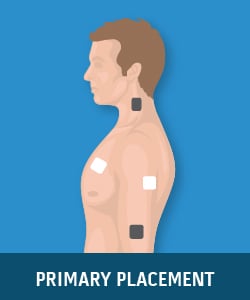
Bicipital Tendonitis
Inflammation or irritation of the upper biceps tendon caused by overuse, tendon impingement, shoulder joint instability or trauma.
Pulse width: 150-160
Pulse rate: 50Hz
Treatment session: Up to 24 hours until initial relief. Then 30 minutes, 3 times a day.
Temporal Mandibular Joint Pain (TMJ)

Temporal Mandibular Joint Pain (TMJ)
Joint and muscle disorder as a result of problems with the jaw, jaw joint or surrounding facial muscles.
Pulse width: 220
Pulse rate: 10Hz
Treatment session: Up to 24 hours in the first 2 days. Then 6 hours per day.
** Note: This is a specific treatment to relax the jaw muscle. This is commonly recommended by a Dentist or Doctor. Please seek proper medical guidance when placing these pads close to the head of face.
Shoulder Pain
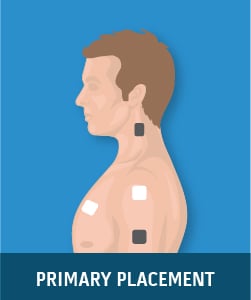
Shoulder Pain
Pain in and around the shoulder that usually originates from the joint itself, or from the surrounding muscles, ligaments and tendons.
Pulse width: 260
Pulse rate: 80-100Hz
Treatment session: Up to 24 hours until initial relief. Then 20-30 minutes, 3 times a day.
Reflex Sympathetic Dystrophy

Reflex Sympathetic Dystrophy
Chronic burning pain typically in the arms and legs, which is thought to be caused by damage to the sympathetic nervous system.
Pulse width: 100-150
Pulse rate: 80-100Hz
Treatment session: Up to 24 hours in the first 4 days. Then 4-6 hours per day.
Cervical Pain

Cervical Pain
Neck pain usually caused by strain or injury, pinched nerves, degenerative disk disease or infections in the throat or neck bones.
Pulse width: 100-150
Pulse rate: 60-100Hz
Treatment session: Up to 24 hours until initial relief. Then 30 minutes, 3 times a day.
Chronic Cervical Strain

Chronic Cervical Strain
Ongoing neck pain typically caused by a history of neck and spinal injuries.
Pulse width: 160
Pulse rate: 30Hz
Treatment session: Up to 24 hours in the first 4 days. Then 4-5 hours per day.
Chronic Cervical Spine Pain

Chronic Cervical Spine Pain
Ongoing neck pain caused by chronic wear on the cervical spine and ageing.
Pulse width: 200
Pulse rate: 10Hz
Treatment session: Up to 24 hours in the first 4 days. Then 4-5 hours per day.
Cervical Osteoarthritis

Cervical Osteoarthritis
A degenerative condition affecting the tissue and bones in the neck, caused by ageing of the intervertebral disks.
Pulse width: 100-150
Pulse rate: 100Hz
Treatment session: Up to 24 hours until initial relief. Then 20-30 minutes, 3 times a day.
Unilateral Cervical Spine Pain

Unilateral Cervical Spine Pain
Neck pain caused by fractures or dislocation of the cervical spine.
Pulse width: 100
Pulse rate: 100Hz
Treatment session: Up to 24 hours until initial relief. Then 30 minutes, 3 times a day.
Atypical Facial Pain

Atypical Facial Pain
Chronic facial pain that does not fulfil any other diagnosis, and has no obvious cause or explanation.
Pulse width: 260
Pulse rate: 100Hz
Treatment session: Up to 24 hours until initial relief. Then 30 minutes, 3 times a day.
Middle Body
Pain and soreness in the middle body abdomen, back, hips and extremities can be caused by a variety of conditions and injuries such as inflammation, poor posture, arthritis, muscle strain, trauma or disease. Acute middle body pains can usually be treated with basic self-care and pain relief, while chronic pains will need ongoing management.

Low Back Pain

Low Back Pain
One of the most common types of pain which is usually caused by problems with the spinal muscles, nerves, bones, discs or tendons.
Pulse width: 260
Pulse rate: 50-80Hz
Treatment session: Up to 24 hours until initial relief. Then 30 minutes, 3 times a day.
Hip Neuralgia

Hip Neuralgia
Nerve pain in the hip which is usually caused by nerve damage or loss of function.
Pulse width: 150-260
Pulse rate: 80-120Hz
Treatment session: Up to 24 hours in the first 4 days. Then 4 hours per day.
Phantom Limb
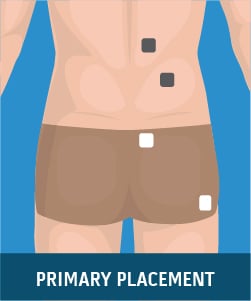
Phantom Limb
Mild to extreme pain in an area where a limb has been amputated, caused by nerve endings at the amputated area continuing to send pain signals to the brain.
Pulse width: 160-200
Pulse rate: 50-100Hz
Treatment session: Up to 24 hours per day in the first week. Then 30 minutes, 3 times a day.
Sciatica

Sciatica
Pain, numbness or weakness in the lower back and leg caused by irritation to the sciatic nerve.
Pulse width: 260
Pulse rate: 150Hz
Treatment session: Up to 24 hours until initial relief. Then 30 minutes, 3 times a day.
Upper Extremity Pain (Reflex Sympathetic Dystrophy)

Upper Extremity Pain (Reflex Sympathetic Dystrophy)
Pain in upper limbs usually caused by a trauma or illness that doesn’t directly damage the nerves in the limbs, but results in severe pain that is out of proportion to the injury.
Pulse width: 220
Pulse rate: 30-50Hz
Treatment session: Up to 24 hours until initial relief. Then 30 minutes, 3 times a day.
Degenerative Arthritis (Cervical and Lumbar)

Degenerative Arthritis (Cervical and Lumbar)
Joint disease caused by the breakdown of cartilage in one or more joints.
Pulse width: 100
Pulse rate: 100Hz
Treatment session: Up to 24 hours until initial relief. Then 30 minutes, 3 times a day.
Lateral Rib Cage Pain

Lateral Rib Cage Pain
Pain in and around the rib cage that can be caused by a tear in the muscle fibres, trauma or injuries, or muscle strain.
Pulse width: 150
Pulse rate: 100Hz
Treatment session: Up to 24 hours until initial relief. Then 30 minutes, 3 times a day.
Chronic Hip Pain
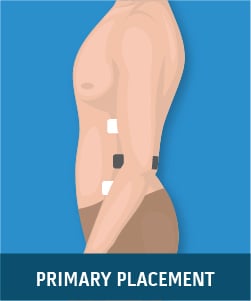
Chronic Hip Pain
Ongoing pain in the hip that is usually as a result of problems with the hip joint, muscles, ligaments, tendons or other soft tissues surrounding the joint.
Pulse width: 200
Pulse rate: 100Hz
Treatment session: Up to 24 hours until initial relief. Then 30 minutes, 3 times a day.
Carpal Tunnel Syndrome

Carpal Tunnel Syndrome
A disorder in the hand and arm, caused by too much pressure on the nerves which run through the wrist.
Pulse width: 260
Pulse rate: 100Hz
Treatment session: Up to 24 hours until initial relief. Then 20 minutes, 3 times a day.
Wrist Pain
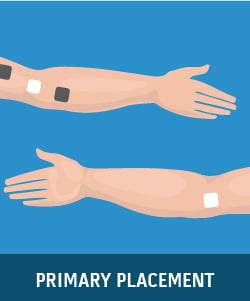
Wrist Pain
A common problem often caused by sprains or fractures, but can also result from long-term conditions such as repetitive stress or arthritis.
Pulse width: 260
Pulse rate: 30-50Hz
Treatment session: Up to 24 hours until initial relief. Then 30 minutes, 3 times a day.
Elbow and Forearm Pain

Elbow and Forearm Pain
Pain typically caused by repetitive strain injuries such as tennis elbow or golfer’s elbow.
Pulse width: 100
Pulse rate: 100Hz
Treatment session: Up to 24 hours until initial relief. Then 30 minutes, 3 times a day.
Ulnar Nerve Lesion

Ulnar Nerve Lesion
Damage or dislocation to the ulnar nerve typically caused by a fracture, or compression of the nerve.
Pulse width: 100
Pulse rate: 100Hz
Treatment session: Up to 24 hours until initial relief. Then 30 minutes, 3 times a day.
Lower Body
Lower body muscles are prone to strain, cramps and overexertion. But pain in the lower body can also be caused by conditions such as arthritis, gout and deep vein thrombosis which may need ongoing medical care. Relief can often be found in gentle exercises, stretching, ice and heat, as well as physical therapy methods like electrical stimulation.
Low Extremity Pain (Reflex Sympathetic Dystrophy)

Low Extremity Pain (Reflex Sympathetic Dystrophy)
Pain in lower limbs usually caused by an injury that doesn’t directly damage the nerves, but results in disproportionate pain to the injury.
Pulse width: 160
Pulse rate: 30-80Hz
Treatment session: Up to 24 hours until initial relief. Then 30 minutes, 3 times a day.
Degenerative Arthritis (Knee)

Degenerative Arthritis (Knee)
Joint disease caused by the breakdown of cartilage in one or more joints.
Pulse width: 220
Pulse rate: 80Hz
Treatment session: Up to 24 hours until initial relief. Then 30 minutes, 3 times a day.
Acute Muscle and Ligament Tear (Ankle)
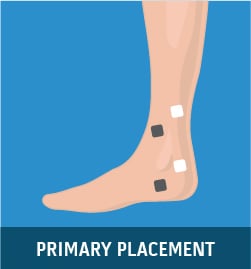
Place one set of electrodes on medial side and one set on literal side
Ankle pain caused by stretching ligaments too far or too quickly, which results in a tear.
Pulse width: 100
Pulse rate: 100Hz
Treatment session: Up to 24 hours until initial relief. Then 30 minutes, 3 times a day.
Post-Podiatric Surgery

Post-Podiatric Surgery
Pain while recovering from reconstructive podiatric surgery.
Pulse width: 100-150
Pulse rate: 100Hz
Treatment session: Up to 24 hours in the first 4 days. Then 4 hours per day.
Knee Pain

Knee Pain
Pain caused by muscle strains, tendinitis and injuries to ligaments and cartilage, usually as a result of sports, exercise and other physical activities.
Pulse width: 100-150
Pulse rate: 120Hz
Treatment session: Up to 24 hours until initial relief. Then 30 minutes, 3 times a day.
Recurrent Patellar Subluxation
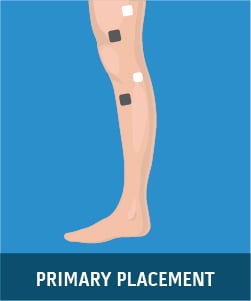
Place one set of electrodes on medial side and one set on lateral side
Knee dislocation and cartilage damage as a result of the kneecap being forced out of its natural position.
Pulse width: 220
Pulse rate: 80Hz
Treatment session: Up to 24 hours in the first 4 days. Then 4 hours per day.
Lower Leg Pain (Diabetic Neuropathy)

Lower Leg Pain (Diabetic Neuropathy)
Nerve damage in the legs and feet associated with diabetics, where high blood sugar injures the nerve fibres.
Pulse width: 100-160
Pulse rate: 60-100Hz
Treatment session: Up to 24 hours until initial relief. Then 30 minutes, 3 times a day.
TENS machines are also effective at treating other types of pain not listed here – talk to your doctor or TENS machine specialist to put together a treatment program for your specific pain.
What has worked for your pain in the past? Has there been a treatment program that you’ve found particularly helpful? Let us know in the comments!
